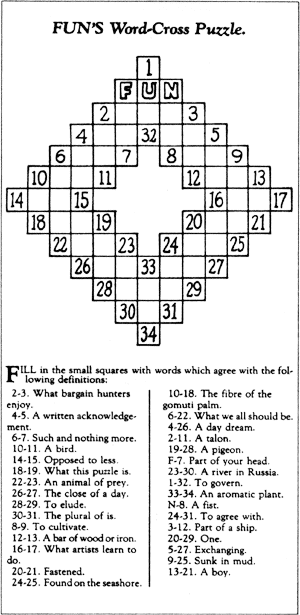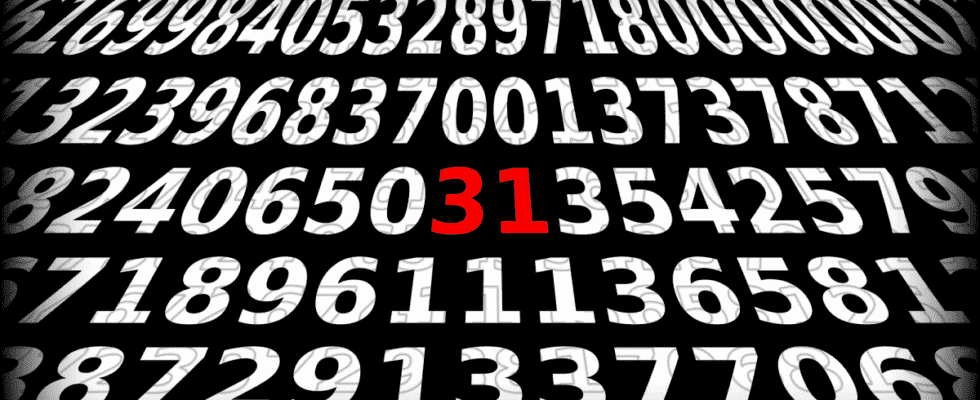For Christmas 1913, the British journalist Arthur Wynneden gave readers of “New York World” a very special pastime: the first word cross appeared. In the first crossword puzzle, which was built in a diamond shape, 31 terms had to be searched for. What was intended as a brain teaser for the Christmas season quickly became an integral part of newspapers in the USA, and later also in Great Britain. The crossword puzzle arrived in Germany around 1925.
Recommended editorial content
With your consent, external content will be loaded here.
For Christmas, Arthur Wynne was supposed to come up with a fun puzzle in the Sunday edition of “New York World” of December 21, 1913 that could keep someone busy for several days. Wynne remembered growing up filling in magic squares with his grandfather in Liverpool. These were Sudoku-like boxes in which every word had to make sense both vertically and horizontally.
This form of puzzle was supposedly invented by the journalist GiuseppeAiroldi, at least his first square puzzle was published on September 12, 1890 in the “Secolo Illustrato della Domenica”. Wynne took up the idea and constructed a large, page-filling “word cross” that was extremely well received by the audience: Immediately after Christmas, the readers asked when the next word cross would appear. With the third word puzzle from Wynne, the word cross became a crossword puzzle due to a mistake by the typesetter.

In this section we always present astonishing, impressive, informative and funny figures from the fields of IT, science, art, economics, politics and of course mathematics on Tuesdays.
All articles on “Pay, please!”
By the time he was naturalized in the USA in 1920, Wynne should have invented over 100 puzzles, constantly refining the development of the puzzle. At the request of the printer, the rhombus became a rectangle that was given a permanent place in many daily newspapers. Originating in the USA, the crossword puzzle first spread to Great Britain and India, and soon afterwards throughout the world. In Great Britain, under the influence of the poet Edward PowysMathers, the independent form of the double-puzzled crossword puzzle developed in the 1920s.

The first crossword puzzle from 1913
His riddles appeared under the name of the inquisitor Torquemada from 1926 to 1939. His heirs were Ximenes, the Latin teacher Derrick Somerset Macnutt and Afrit, in civil life Alistair Ferguson Ritchie. The British tradition is continued in Germany in the daily newspaper’s crossword puzzles. The recently deceased composer and librettist Stephen Sondheim re-imported this puzzle variant in the USA. His best-known song Send in the Clowns was asked for in numerous crossword puzzles.
The crossword puzzle reached a memorable climax in the Second World War, when the deciphering department “Bletchley Park” was set up in Great Britain. Code breakers like Alan Turing worked here to decipher the encrypted radio messages from the Germans. It was possible to search for unsuitable candidates via newspaper advertisements without endangering the top-secret project. That’s why they used a particularly tricky crossword puzzle.
Anyone who could solve it or decipher it in less than 12 minutes was invited to work in Bletchley Park. One of the more well-known crossword puzzles is the one that appeared in the United States on November 5, 1996, the day the next US president was elected. Look for the headline of the next day under 39. The puzzle was structured in such a way that “Clinton Elected” and “Bob Dole Elected” were possible as a solution.
Send in The Clowns is a piece from Steven Sontheim’s musical “Musical A Little Night Music”, here in the version by Judy Collins. Sontheim claimed to have made the legendary conductor Leonard Bernstein addicted to crossword puzzles.
Also memorable is the crossword puzzle that appeared in the New York Times on October 7, 2011 after Steve Jobs died. It consisted of terms like “Think Different”, Macintosh or “Creative Genius” that shaped Jobs’ life. Of course, Apple was also advisable: The Crossword Magic software from L&S Computerware for the Apple II was a very popular program for crossword puzzle fans in the early 1980s.
If the Guinness Book of World Records is correct, then the Briton Roger Squires is the king of crossword puzzles. In 22 years he has published a total of 74,634 crossword puzzles in eight daily newspapers and holds the record for the longest word that had to be found in a crossword puzzle, the Welsh village of Llanfairpwllgwyngyllgogerychwyrndrobwllllantysiliogogogoch.
Today, crossword puzzles are mostly produced by software. The company Crossdown Puzzles of the cryptologist and crossword puzzle maker Sam Bellotto is said to be the market leader in Anglo-American countries. Solving crossword puzzles can also be done by computers, either with the help of search algorithms and powerful databases or with the help of neural networks. As proof of the functioning of artificial intelligence, the crossword puzzle has had its day since the 1990s.
If you have problems playing the video, please activate JavaScript
(mawi)
